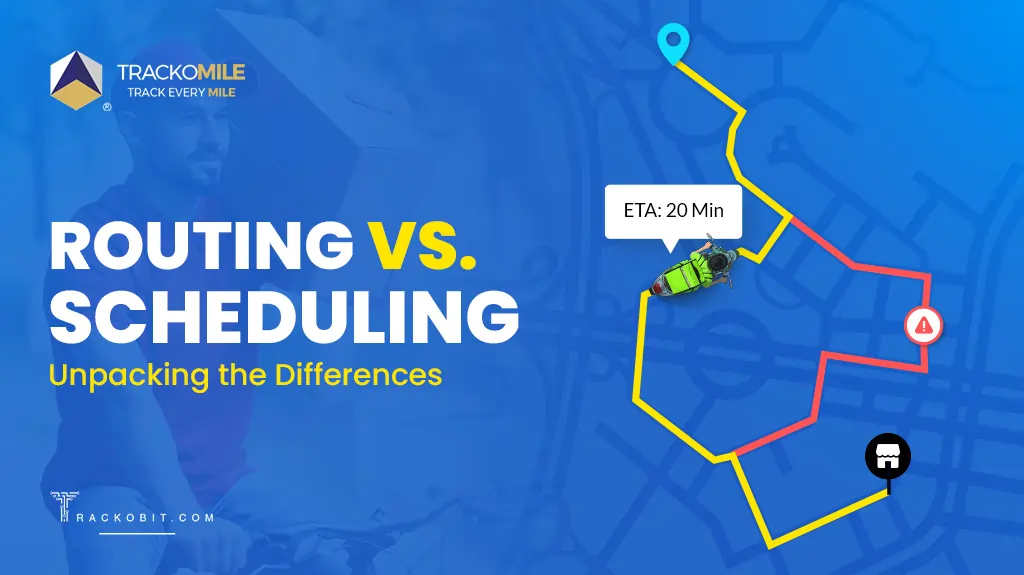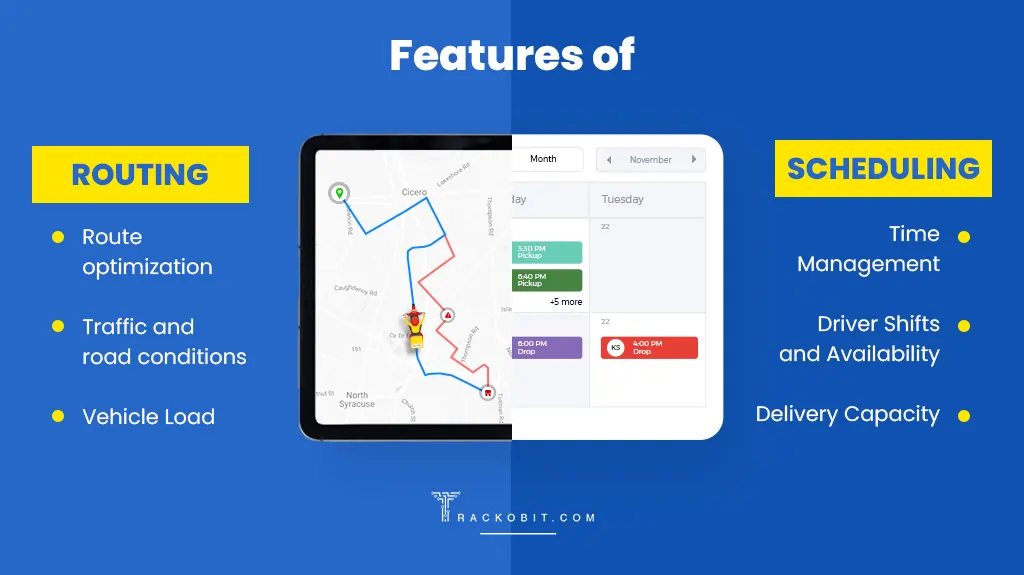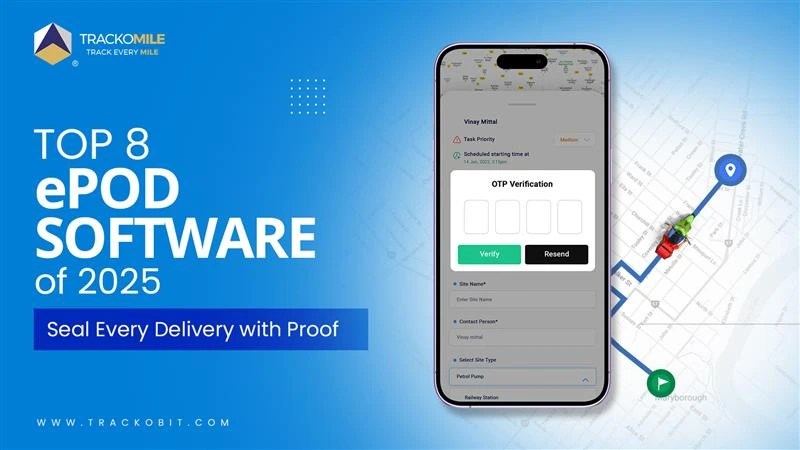-
TrackoBit
Manage commercial vehicles with the new-age Fleet Management Software
TrackoBit -
TrackoField
Streamline your scattered workforce with Field Force Management Software
TrackoField -
Features Resources
-
Blog
Carefully curated articles to update you on industrial trends. -
White Paper
Insightful papers and analysis on essential subject matters. -
Glossary
Explore an alphabetical list of relevant industry terms. -
What’s New
Get TrackoBit & TrackoField monthly updates here. -
Case Study
Explore the cases we solved with our diverse solutions. -
Comparisons
Compare platforms, features, and pricing to find your best fit.
-
About Us
Get to know TrackoBit: our team, ethos, values, and vision. -
Careers
Join the most dynamic cult of coders, creatives and changemakers. -
Tech Support
Learn about our technical support team and services in detail. -
Events
Check out the exhibitions where we left our marks and conquered. -
Contact Us
Connect with us and let us know how we can be of service.
Routing and Scheduling: The Key Differences
- Author:Tithi Agarwal
- Read Time:9 min
- Published:
- Last Update: December 9, 2025
Table of Contents
Toggle
Are you confused between “routing” and “scheduling,” and are you looking for ways to have the best of both worlds? Why not opt for routing and scheduling software that optimizes business operations?
Table of Contents
Toggle
If you are a fleet manager overseeing delivery operations, you must have heard ‘scheduling’ and ‘routing’, two of the most common logistics terms. Not just that, you may already be applying them manually, via navigation apps, or through software equipped with route optimization functionality.
But the question is: Do you know how these terms differ?
While “route scheduling” and “routing” are closely related, they are distinct facets of the delivery process. However, they together form the cornerstone of successful delivery management.
Therefore, understanding their differences, distinct advantages, and how you can optimize this combination is vital to amplify your delivery capabilities. So, let’s have a look at the meaning and benefits of route scheduling. It also explains how scheduling is different from routing with a real-life example and discusses tips for improving it.
What is Routing?
Routing is the strategic process of determining the most efficient routes for drivers to deliver goods, ensuring that delivery requests are addressed quickly and effectively. This involves mapping out specific paths that drivers should follow, considering multiple factors to create an optimized route plan.
Route planning transforms a delivery schedule into optimized paths for delivery drivers or service professionals. It considers various elements, such as vehicle capacity, travel time, fuel costs, and transportation expenses, to design routes that maximize efficiency and minimize costs.
The primary goal of efficient routing for the last phase of delivery is to reduce travel time, mileage, and fuel consumption. This process involves analyzing numerous factors, including road conditions, traffic patterns, vehicle capacities, and specific delivery time windows. By optimizing these variables, routing enhances operational efficiency, reduces costs, and ensures timely deliveries.
What are the Key Features of Routing?
1. Route optimization
This is the cornerstone of efficient delivery management. It involves finding the most effective path for delivery vehicles to make all the necessary stops in the best possible order. This process often depends on calculated algorithms that solve complex routing and delivery issues.
Algorithms are mathematical approaches that consider multiple factors (in the case of TrackoMile, its 120+ factors), including distance, time, fuel consumption, and the priority of different deliveries.
Route optimization goes beyond static planning, incorporating dynamic rerouting capabilities to reroute real-time paths as conditions change. To handle the complexity of large-scale route planning for the entire fleet of riders and delivery schedules, the software has integrated machine learning and artificial intelligence to predict optimal routes based on historical data and observed patterns, continually improving routing.
As we know, the best and quickest routes to delivery save time, effort, and cost, elevating business standards.
2. Dynamic Re-routing (based on traffic and road conditions)
Overseeing and coordinating traffic and road conditions is crucial for accurate and efficient route planning. This involves integrating real-time traffic data to get live information on traffic blocks or diversions across the delivery area. Route planning managers must also factor in information about ongoing or planned construction work, accidents, or other temporary road closures that could impact travel times.
Weather conditions are critical to routing. Any adverse conditions can significantly impact both travel times and road safety. Last-mile delivery businesses use TrackoMile, backed by route optimization algorithms that analyze historical traffic data to predict future conditions at different times of the day or on different days of the week. This is vital for accurate long-term planning. With such meticulous data, you can provide drivers with alternative route suggestions in case of unexpected delays or closures during their journey.
3. Vehicle Load
This is another critical factor in route planning. It involves more than simply matching cargo volume to vehicle size and requires a deeper understanding of how to utilize each vehicle’s capabilities best. Load optimization ensures that each vehicle is filled to its ideal capacity without exceeding weight limits or compromising safety.
Route planners must also consider each vehicle’s specific characteristics when assigning routes to ensure smooth delivery. In some cases, efficient routing involves planning multi-trip routes where vehicles return to a depot for reloading during a shift. Balancing load weight with fuel consumption is key, as heavier loads can significantly impact fuel efficiency and overall operational costs.

Features of Routing and scheduling
What is Scheduling?
Scheduling involves planning delivery timings and assigning drivers for tasks. It optimizes workloads and manages the available workforce, considering constraints such as driver shifts, customer preferences, and delivery time windows. The main objective of scheduling is to efficiently assign delivery orders to available time slots. This planning helps ensure seamless operation and customer satisfaction.
Key Features of Scheduling
1. Time Management
This crucial scheduling aspect involves assigning specific delivery timeframes based on customer preferences and operational constraints. This process requires balancing customer requirements with the logistical constraints of delivery. To manage time windows effectively, you must consider factors such as peak traffic hours, delivery location accessibility, and the nature of the goods being delivered. It may involve offering customers a choice of delivery slots or working within pre-established timeframes.
The goal is to create a schedule that satisfies customer expectations while maintaining operational efficiency. This often requires sophisticated algorithms that can simultaneously juggle multiple time constraints, ensuring that deliveries are planned to minimize travel time between stops while meeting promised delivery windows.
2. Driver Shifts and Availability
As we know, any amount of automation still requires human intervention. As part of scheduling, the most important players are the drivers. Their shift timings, skills, and capacity have to be considered prior to assigning a delivery task. All delivery routes must be designed to fit within the available work hours of delivery drivers. So, factors such as shift patterns, legally mandated break times, and maximum working hours are to be considered. TrackoMile’s rider roaster manages this by efficiently monitoring driver and vehicle schedules.
Effective route planning must also consider the drivers’ well-being, fatigue levels, and overall health to ensure that routes are efficient and sustainable from a human perspective. This process involves shuffling drivers in shifts or assigning different routes to provide a balanced workload. As routing does, scheduling involves planning for unexpected events, such as traffic delays or vehicle breakdowns, and building in appropriate buffer time.
3. Customer Delight
The ultimate goal of delivery route scheduling is customer satisfaction. That’s why last-mile delivery businesses increasingly try to accommodate individual preferences for delivery times within the bounds of feasibility. Customers are also given the choice of a range of delivery slots, specific delivery days, or even time ranges.
However, this taxing process must be planned to achieve operational efficiency. The challenge lies in finding the balance between customer satisfaction and cost-effective processes. The benefit of using scheduling and routing software is that it shares ETAs with the customers so that they know when to expect their order delivery.
4. Economical Operations
By scheduling, you can optimize delivery operations and resource utilization, reduce costs, improve customer satisfaction, and enhance overall operational efficiency. One of the primary benefits is reduced operational costs.
When delivery vehicles ply the shortest and most efficient paths, route scheduling minimizes travel distance and fuel consumption. This leads to direct savings on fuel costs and reduces labor costs by minimizing drivers’ time on the road. Additionally, by reducing unnecessary mileage and vehicle wear and tear, effective route scheduling can significantly lower maintenance costs.
5. Delivery Time Management
Delivery consumes a lot of on-road time. It also includes wait time (if there are any roadblocks), weather conditions, and other unexpected situations. Route scheduling or optimizing routes, enables vehicles to reach their destinations faster, thereby reducing overall delivery time.
Quicker deliveries always make customers happy, and they will most likely choose your services over other providers. With advanced route scheduling tools like TrackoMile’s Route Optimization, you can even account for real-time traffic conditions, allowing for dynamic route adjustments that save additional time.
6. Delivery Capacity
Scheduling increases delivery capacity to its fullest. This ensures that vehicles are loaded to their maximum capacity and deliveries are planned for minimal backtracking. Managing delivery capacity leads to fewer trips for the same number of deliveries, reducing costs and environmental impact. Strategically planned and sequenced deliveries contribute to smoother operations and can help in managing time-sensitive deliveries more efficiently.
Difference Between Route Scheduling and Routing
Some vital differences between scheduling and routing
| Aspects | Routing | Route Scheduling |
| Definition | Determining the most efficient paths or sequences for delivery vehicles.. | Deciding when specific tasks or deliveries should be performed within a given timeframe. |
| Purpose | Optimal paths for vehicles, considering factors like distance, traffic, and road conditions. | Timing and sequence of deliveries, considering factors like delivery time slots and urgency. |
| Decision scope | Physical paths that vehicles should take. | Timing and sequence of deliveries within a given timeframe. |
| Key Considerations | Geographic factors, road conditions, and efficiency in travel paths. | Specific delivery time windows, urgency, and resource availability |
| Core Objectives | The primary objective of routing is to optimize routes for your delivery drivers to follow. It aims to find the shortest, fastest, and most cost-efficient path. |
|
| Processes | Routing involves creating an optimal plan on paper or in a computer system. It typically considers real-time factors such as traffic conditions. | It considers dynamic factors like vehicle availability, drivers’ working hours, up-to-date traffic information, and unexpected events. |
| Inputs | Route planning creates routes by considering details, including customers’ locations, vehicle capacities, and road networks. | Route scheduling weighs real-time information such as the vehicle’s location or priority changes to create routes. |
| Optimization criteria | Route planning aims to optimize routes according to distance, travel time, and fuel consumption. | Contrarily, route scheduling focuses on optimizing and readjusting already planned routes based on real-time data. |
How to Optimize Routing and Scheduling Process?
Optimizing routing and scheduling is essential for maximizing operational efficiency and reducing costs. Here are some strategies and best practices to achieve optimal routing and scheduling:
- Leverage Advanced Route Optimizing Software: Sophisticated route optimization software like TrackoMile can significantly enhance your routing and scheduling capabilities. TrackoMile uses advanced routing algorithms to calculate the most efficient routes based on various factors, such as traffic conditions, delivery windows, vehicle capacities, and more.
- Incorporate Real-Time Data: Real-time data integration allows businesses to adjust routes and schedules on the fly based on current conditions such as traffic, weather, and road closures. This dynamic approach helps mitigate delays and maintain punctual deliveries.
For example, a courier delivery company integrates real-time traffic data into TrackoMile, allowing dispatchers to reroute delivery agents in case of traffic jams, ensuring timely delivery of orders.
- Analyze Historical Data: Reviewing historical data on delivery times, route efficiency, and customer feedback can provide insights into recurring issues and areas for improvement. This data-driven approach helps in refining routing and scheduling strategies over time.
- Prioritize Based on Delivery Windows: Scheduling deliveries within specified time windows can enhance customer satisfaction and operational efficiency. Prioritizing routes based on these windows ensures that high-priority deliveries are made first.
For example, a medical supply company prioritizes deliveries to hospitals and clinics based on their operating hours and urgency, ensuring that critical supplies are delivered within the required time frames.
- Optimize Rider Schedule: Rider roasters for delivery companies ensure effective routing and scheduling so that all vehicles and drivers are utilized to their maximum potential. This includes minimizing complexities and confusion, balancing workloads, and planning routes that cover the most ground in the least amount of time.
- Implement Predictive Analytics: Predictive analytics can forecast potential delays and disruptions, allowing businesses to adjust their routes and schedules proactively. This approach helps minimize unexpected issues and maintain smooth operations.
For instance, a package delivery service uses predictive analytics through TrackoMile to anticipate weather-related delays, adjusting schedules and routes in advance to avoid affected areas and ensure timely deliveries.
For Efficient Routing and Scheduling Software – Choose TrackoMile
Optimizing routing and scheduling is essential for any business that relies on transportation and logistics. By leveraging routing software or delivery management software, analyzing data, and prioritizing efficiency, companies can significantly reduce costs, enhance customer satisfaction, and improve overall operational efficiency.
When it comes to choosing the right route planning and optimizing software, TrackoMile stands out as a top choice. By choosing TrackoMile, you’re not only investing in a tool that optimizes routes and schedules but also in a solution that scales with your business, adapts to your needs, and enhances your ability to deliver exceptional service to your customers.
Tithi Agarwal is an established content marketing specialist with years of experience in Telematics and the SaaS domain. With a strong background in literature and industrial expertise in technical wr... Read More
Related Blogs
-

How Rider Tracking Software Improves Delivery Accuracy and Reduces Fraud
Tithi Agarwal December 8, 2025Rider tracking software improves delivery accuracy with real-time GPS visibility and automated ePOD. It also enables route optimisation and fraud…
-

Top Electronic Proof of Delivery (ePOD) Software in 2026
Tithi Agarwal September 25, 2025Electronic proof of delivery has become the backbone of modern logistics. Explore the top 8 ePOD software in 2026 and…
-

3PL vs. 4PL: Which is Best for Your Business?
Tithi Agarwal September 25, 2024Confused about choosing between 3PL and 4PL for your retail supply chain? Read this blog to find out which is…
-

What is Payload Capacity? Payload Capacity Vs. Towing Capacity
Tithi Agarwal September 10, 2024Payload capacity is the total weight a vehicle can safely carry, and it is crucial for safety and compliance. Exceeding…

Subscribe for weekly tips to supercharge your last-mile delivery.
Your inbox awaits a welcome email. Stay tuned for the latest blog updates & expert insights.
"While you're here, dive into some more reads or grab quick bites from our social platforms!"Stay Updated on tech, telematics and mobility. Don't miss out on the latest in the industry.
We use cookies to enhance and personalize your browsing experience. By continuing to use our website, you agree to our Privacy Policy.




































